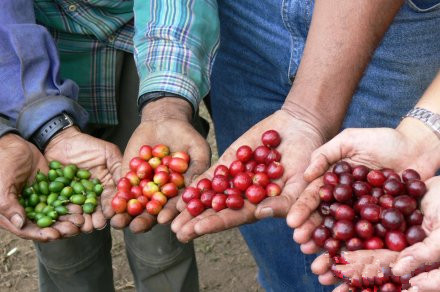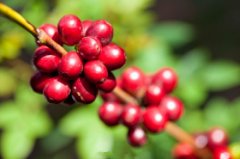Basic knowledge of Fine Coffee the harvesting method of coffee beans

The harvest time and method of coffee vary from place to place, generally speaking, once or twice a year (sometimes up to three or four times). The harvest time is mostly in the dry season. In Brazil, for example, around June, it starts in the north-eastern state of Bahia and ends in October in the southern state of Parana. The harvest period for Central American countries is from September to January of the following year, from lowlands to highlands.
Harvesting methods can be divided into two categories, one is hand picking method, the other is shaking method.
(1) hand picking
With the exception of Brazil and Ethiopia, most Arabica coffee-producing countries are harvested by hand. Hand picking not only removes ripe bright red coffee, but also sometimes along with immature cyan beans and branches, so these immature beans are often mixed with refined coffee beans, especially when they are refined by natural drying. If these beans are mixed with baking, they will produce a disgusting stench.
(2) shake-down method
This method is to hit the ripe fruit or shake the coffee branch with a random stick, so that the fruit falls and accumulates into a pile. Larger estates use large harvesters, while small and medium-sized farms harvest with a sea of people mobilized by the whole family. This method of shaking the fruit off the ground is easier to mix with impurities and defective beans than the hand-picking method, and beans from some places can be stained with a strange smell or fermented because the ground is wet. Producers of Robusta coffee beans such as Brazil and Ethiopia are mostly harvested in this way.
Countries harvested by shaking and falling method also adopt natural drying method to refine coffee beans. Coffee blossoms in spring, bears fruit in summer and harvests in winter, so it is very difficult to harvest and dry in places where there is no clear distinction between drought and rainy seasons. in the rainy season, it is impossible to use natural drying. Therefore, coffee is suitable for growing in areas with early and rainy seasons.
Important Notice :
前街咖啡 FrontStreet Coffee has moved to new addredd:
FrontStreet Coffee Address: 315,Donghua East Road,GuangZhou
Tel:020 38364473
- Prev

Planting skills of Coffee trees Coffee sowing method
The coffee wrapped in endocarp will be planted to the seedbed and will germinate in 40-60 days and grow to about 50 cm in about 6 months after germination. At this stage, the seedlings are still fragile and must be covered with cold gauze and other things to block direct sunlight. The seedlings blossomed about three years after they were transplanted from the seedbed to the garden. In this period, Central America and other countries that use hand-picking to harvest coffee beans, for
- Next

Important conditions for coffee cultivation three necessary environmental factors for planting coffee trees
There is a noun called coffee belt. There are more than 60 coffee producing countries in the world, most of which are located in the tropics and subtropics between the Tropic of Cancer (latitude 2326). This coffee growing area is called coffee belt (Coffee Belt) or coffee area (Coffee Zone). The annual average temperature of the coffee belt is above 20 ℃, because the coffee tree is a tropical plant, if the temperature is below 20 ℃.
Related
- Beginners will see the "Coffee pull flower" guide!
- What is the difference between ice blog purified milk and ordinary milk coffee?
- Why is the Philippines the largest producer of crops in Liberia?
- For coffee extraction, should the fine powder be retained?
- How does extracted espresso fill pressed powder? How much strength does it take to press the powder?
- How to make jasmine cold extract coffee? Is the jasmine + latte good?
- Will this little toy really make the coffee taste better? How does Lily Drip affect coffee extraction?
- Will the action of slapping the filter cup also affect coffee extraction?
- What's the difference between powder-to-water ratio and powder-to-liquid ratio?
- What is the Ethiopian local species? What does it have to do with Heirloom native species?

